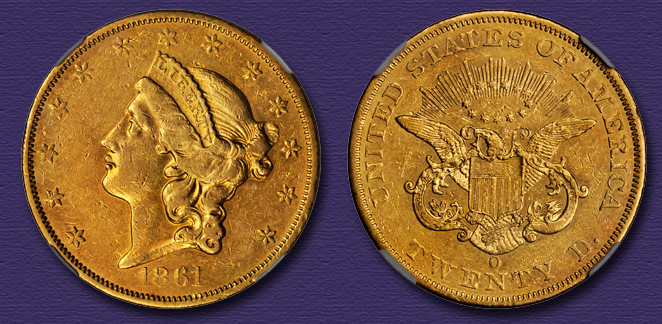
A rare and historic 1861-O double eagle will be featured in our February 2014 Americana Sale in New York City. Graded AU-50+ by NGC, it is ranked at a very respectable grade level for this genuinely scarce, fascinating and prized issue — the final date of production for New Orleans double eagles until 1879. The coin is described as follows:
A pleasantly sharp example of this rare New Orleans issue, which is generally one of the weakest struck double eagles from this mint. Some softness is seen in the obverse stars, largely from star three through eight, but even these are all completely outlined and some are sharp enough to show the centers. The remaining stars all show their centers. The bases of the date digits are also soft, mostly at 18. Interestingly, the base of the 8 seems to have been somewhat crudely strengthened in the die, as mentioned by Doug Winter in Gold Coins of the New Orleans Mint 1839-1909, and as seen on one of the two examples owned by Harry W. Bass. The reverse shows much better detail, with legends sharp and all central details well executed for the issue. Even the wing tips show full separation in the feathers. Generous traces of Prooflike reflectivity are seen on the reverse, most dramatically close to the devices where the fields are best protected. On the obverse good luster remains, again, in the protected areas. Scattered light handling marks are commensurate with the grade, but none stand out as particularly noteworthy or distracting, a welcomed change from those sometimes seen with heavy bagmarks.
Just 17,741 $20 coins were struck at New Orleans this year, but interestingly, it is believed that not all were by the United States, making this one of the most interesting issues of the Liberty double eagle series. As published by Doug Winter, it is believed that approximately 5,000 pieces were made by the United States, struck from January 1st through January 26th, 1861. Thereafter, the forces of the State of Louisiana took control of the facility and continued production striking 9,750 through March 31, 1861. Finally, the Confederate States government took control and struck the remaining 2,991 coins in April. The determination of which coins were produced by which authority remains uncertain, unfortunately. However, it is proposed by Doug Winter that coins seen with a strong date and die cracks are those struck by the Confederate States. Either way, it is quite interesting that, as the country descended into the Civil War, someone at the mint bothered to notice the weak date on this variety and took the time to try to sharpen the base of the 8. It is a bit hard to imagine, but a testament to the level of attention paid to the production of coins at the time.
As mentioned, many examples of this date show heavy marks and the typical coin is in the Very Fine or Extremely Fine range. Coins graded About Uncirculated are quite scarce and only six Mint State coins have been graded by PCGS and NGC, though there could be duplication in those figures. Any coin at the grade level seen here is suitable for a fine collection of double eagles or of Civil War dates.





